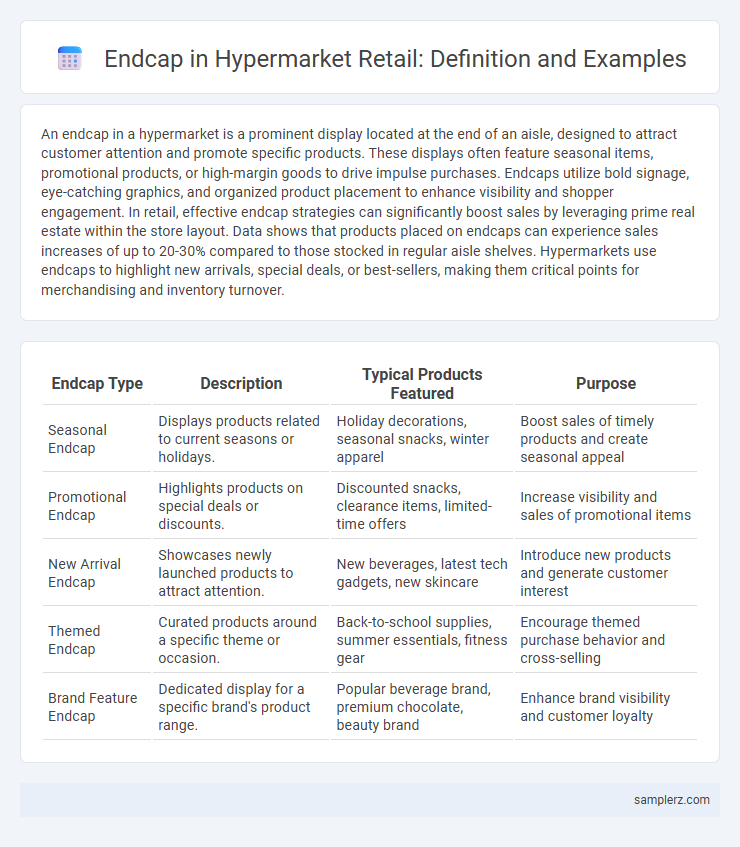An endcap in a hypermarket is a prominent display located at the end of an aisle, designed to attract customer attention and promote specific products. These displays often feature seasonal items, promotional products, or high-margin goods to drive impulse purchases. Endcaps utilize bold signage, eye-catching graphics, and organized product placement to enhance visibility and shopper engagement. In retail, effective endcap strategies can significantly boost sales by leveraging prime real estate within the store layout. Data shows that products placed on endcaps can experience sales increases of up to 20-30% compared to those stocked in regular aisle shelves. Hypermarkets use endcaps to highlight new arrivals, special deals, or best-sellers, making them critical points for merchandising and inventory turnover.
Table of Comparison
| Endcap Type | Description | Typical Products Featured | Purpose |
|---|---|---|---|
| Seasonal Endcap | Displays products related to current seasons or holidays. | Holiday decorations, seasonal snacks, winter apparel | Boost sales of timely products and create seasonal appeal |
| Promotional Endcap | Highlights products on special deals or discounts. | Discounted snacks, clearance items, limited-time offers | Increase visibility and sales of promotional items |
| New Arrival Endcap | Showcases newly launched products to attract attention. | New beverages, latest tech gadgets, new skincare | Introduce new products and generate customer interest |
| Themed Endcap | Curated products around a specific theme or occasion. | Back-to-school supplies, summer essentials, fitness gear | Encourage themed purchase behavior and cross-selling |
| Brand Feature Endcap | Dedicated display for a specific brand's product range. | Popular beverage brand, premium chocolate, beauty brand | Enhance brand visibility and customer loyalty |
What is an Endcap in Hypermarkets?
An endcap in hypermarkets is a prominent display located at the end of an aisle designed to showcase featured products, seasonal items, or promotions. Endcaps attract customer attention by capitalizing on high-traffic zones, increasing product visibility and boosting impulse purchases. Effective endcaps often combine strategic product placement with eye-catching signage to enhance shopper engagement and drive sales.
Popular Endcap Display Examples
Popular endcap display examples in hypermarkets include seasonal product promotions like holiday-themed snacks and beverages strategically placed to attract impulse buyers. Another effective endcap design features new product launches prominently positioned near the checkout area to maximize visibility and encourage trial purchases. Combining high-demand items such as cleaning supplies or personal care products with eye-catching signage further boosts customer engagement and sales.
Seasonal Promotions on Hypermarket Endcaps
Hypermarket endcaps featuring seasonal promotions significantly boost impulse purchases by showcasing holiday-themed products like Christmas decorations, Easter chocolates, or summer grilling essentials. Strategic placement of these endcaps near high-traffic aisles maximizes visibility, driving increased footfall and sales during key retail periods. Data shows that endcap displays can increase sales of promoted seasonal items by up to 30%, highlighting their effectiveness in retail merchandising.
New Product Launches via Endcap Displays
Endcap displays in hypermarkets serve as high-visibility zones strategically positioned at aisle ends, optimizing consumer engagement during new product launches. These displays utilize eye-catching signage and organized product placement to differentiate new items from existing inventory, driving trial and boosting initial sales performance. Metrics such as increased foot traffic near endcaps and higher purchase conversion rates validate their critical role in effective retail marketing strategies.
Cross-Merchandising Endcap Strategies
Endcaps in hypermarkets serve as prime locations for cross-merchandising by pairing complementary products such as snacks with beverages or pasta with sauces, enhancing impulse purchases. Strategic placement of health supplements alongside fitness equipment targets health-conscious shoppers, driving increased basket size and customer satisfaction. Effective cross-merchandising endcap strategies leverage product synergy, seasonal trends, and customer shopping behaviors to maximize sales and streamline the shopping experience.
Impulse Buy Endcap Placement Examples
Impulse buy endcap placement in hypermarkets often features small, high-demand items like snacks, beverages, and personal care products positioned near checkout lanes or store entrances to capture spontaneous purchases. Seasonal goods and limited-time offers are strategically displayed on endcaps to create urgency and drive additional sales. Effective use of bold signage and product variety on these endcaps significantly boosts average transaction value by encouraging last-minute buying decisions.
Branded Endcap Partnerships in Hypermarkets
Branded endcap partnerships in hypermarkets significantly boost product visibility and drive impulse purchases by positioning high-demand items at strategic aisle ends. These endcaps typically feature exclusive promotions, eye-catching displays, and collaborative branding with major consumer goods companies, enhancing shopper engagement. Hypermarkets leverage these partnerships to optimize shelf space and maximize sales conversion rates on premium products.
High-Margin Product Endcaps
High-margin product endcaps in hypermarkets often feature premium snacks, organic beverages, or luxury cosmetics, strategically positioned to attract impulse buyers. These displays increase visibility and drive sales by grouping complementary or exclusive items in high-traffic areas near checkout lanes or aisle intersections. Retailers optimize endcap layouts using sales data analytics to maximize profitability and enhance shopper engagement.
Thematic Endcap Display Inspirations
Thematic endcap displays in hypermarkets effectively capture customer attention by showcasing seasonal products, such as summer BBQ essentials or holiday gift bundles, arranged with vibrant signage and coordinated packaging. Strategic placement at aisle intersections or near checkout counters boosts impulse purchases while highlighting key promotions and complementary items. Incorporating interactive elements like QR codes or product samples further enhances shopper engagement and drives sales performance.
Data-Driven Endcap Success Stories
Data-driven endcaps in hypermarkets boost sales by leveraging customer purchase patterns and inventory analytics to optimize product placement. For instance, a leading retailer increased snack sales by 30% after strategically positioning complementary items on endcap displays based on real-time sales data. Utilizing machine learning algorithms to analyze shopper behavior, hypermarkets enhance endcap effectiveness, driving higher engagement and revenue.

example of endcap in hypermarket Infographic
 samplerz.com
samplerz.com